Scientists with the National High Magnetic Field Laboratory (Magnet Lab) at the University of South Florida say that they were recently able to conduct the first-ever study on ancient Martian crust samples, which they were able to recover from an extremely old meteorite found in the Sahara desert.
The investigation helps scientists gain a deeper understanding of the Red Planet's history. Current missions on Mars investigate the crust as it appears today, nearly 4.5 billion years after the planet formed. The meteorite that was once ejected from our neighboring world is 4.4 billion years old.
As such, it was produced during a time when the planet looked very differently that it does today. The rock probably spent at least several hundreds of millions of years traveling around the Sun, until it finally came to Earth. It was uncovered by accident by a tribe of Bedouins.
The material removed from this meteorite is the first sample of ancient Martian crust ever discovered. Leading the study effort was FSU and Magnet Lab professor Munir Humayun. Details of the research appear in this week's issue of the top scientific journal Nature.
For this study, the team used an array of highly sophisticated mass spectrometers. Working together, these devices were able to identify and analyze extremely small amounts of chemicals in the space rock, which is known as NWA 7533.
The research group found important amounts of the metal iridium, which suggests that the meteorite was formed somewhere in a cratered area in the southern Martian hemisphere, most likely during the Late Heavy Bombardment. This was a tumultuous period in the history of the solar system when asteroids and comets battered the inner planets into oblivion.
“This cratered terrain has been long thought to hold the keys to Mars’ birth and early childhood,” explains Humayun, who is based at the FSU Department of Earth, Ocean and Atmospheric Science.
The researcher and his team were also able to calculate the thickness of the Martian crust at the time when the meteorite was produced. Results show that, unlike Earth, Mars did not experience a catastrophic impact that melted the surface of the entire planet in its early history.
The age of NWS 7533 “is about 100 million years after the first dust condensed in the solar system, We now know that Mars had a crust within the first 100 million years of the start of planet building, and that Mars’ crust formed concurrently with the oldest crusts on Earth and the Moon,” Humayun concludes.

 14 DAY TRIAL //
14 DAY TRIAL //